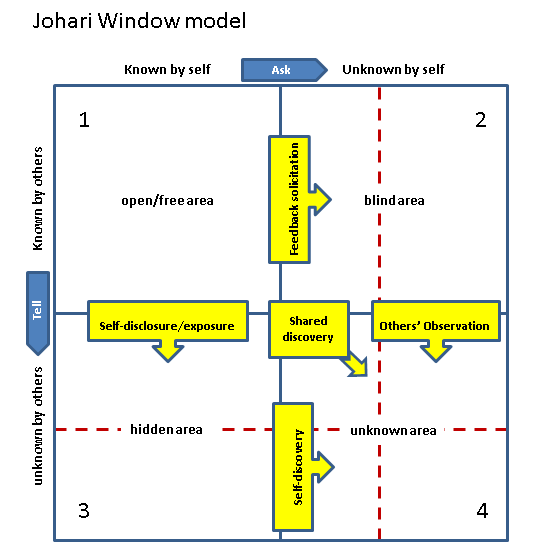After the initial post on Pane 1 we are now getting to a slightly more challenging area – what we call our blind spots.
These are contained in Pane 2, and are known to others but not to ourselves. It is represented in the Top Right of the Window.
The thing about blind spots is we are not consciously aware of them. (If we were they would not be blind spots)! In Pane 2 we are sure that we are right, that is, we do not (consciously) know that we do not know.
For people who work with families in the Focus Group this is potentially a very dangerous area.

At worst Pane 2 represents the part of us that is frightened to engage in open and honest communication and leads us to play games, trick others, hide our true self, and behave out of fear. As meaningful relationships are heavily dependent on openness, honesty and trust a big Pane 2 may prevent us from developing such relationships.
We risk engaging in behaviours that focus, unknowingly, on our own needs. As all behaviours involve decision-making, what we are doing is continually making decisions to satisfy needs that we have but are not aware of.
For example, we may need to be the centre of attention so we self-disclose too much, or we fear genuine relationship so we don’t self-disclose at all.
However, others will probably be intuitively aware of our needs and due to their perception of our non-awareness they will feel insecure and ungrounded.
There are various outcomes of those of us who work with people in distress not attending to their Pane 2. These outcomes might be that people:
- Simply drift away from us and/or our organisation.
- Assume that a state of unawareness is healthy because an expert modelled it!
- End up more hurt than they were prior to meeting us.
- Take legal action against our organisation for professional incompetence if things turn out bad.
Feedback was mentioned when we were describing Pane 1.
Willingness to listen to, and take on board, honest feedback is vital for reducing Pane 2, as is monitoring our emotional state in the company of trusted others. This will give us closer self-perception and thus will match what others around us perceive about us and feed back to us.
What about positive feedback? This may also give us an insight into blind spots. They could be good things about ourselves that we might not be aware of. It’s amazing how many people who are resistant to hearing feedback that is negative can often also dismiss feedback that is positive. (What does he want from me)?
Sometimes our blind spot is called our shadow. As I mentioned in this post where I described the beauty and benefits of darkness, our shadow is not always negative – it can contain positive aspects to our personality and/or behaviour too – it’s just that they may be hidden, or partially hidden from us.
The most difficult feedback of course can be that which is spontaneously directed at us in a flash of anger!
Yet there can be great learning opportunities in this if we do not dismiss it all – and allow for the possibility that there might be a little truth amidst all the angry feedback.
Integration, wisdom, maturity, and above all empathy widen the public area (Pane 1) and reduce the blind area (Pane 2).
